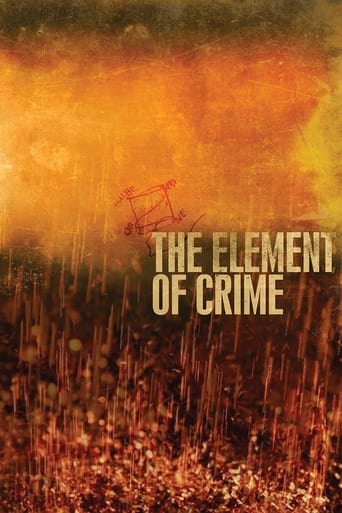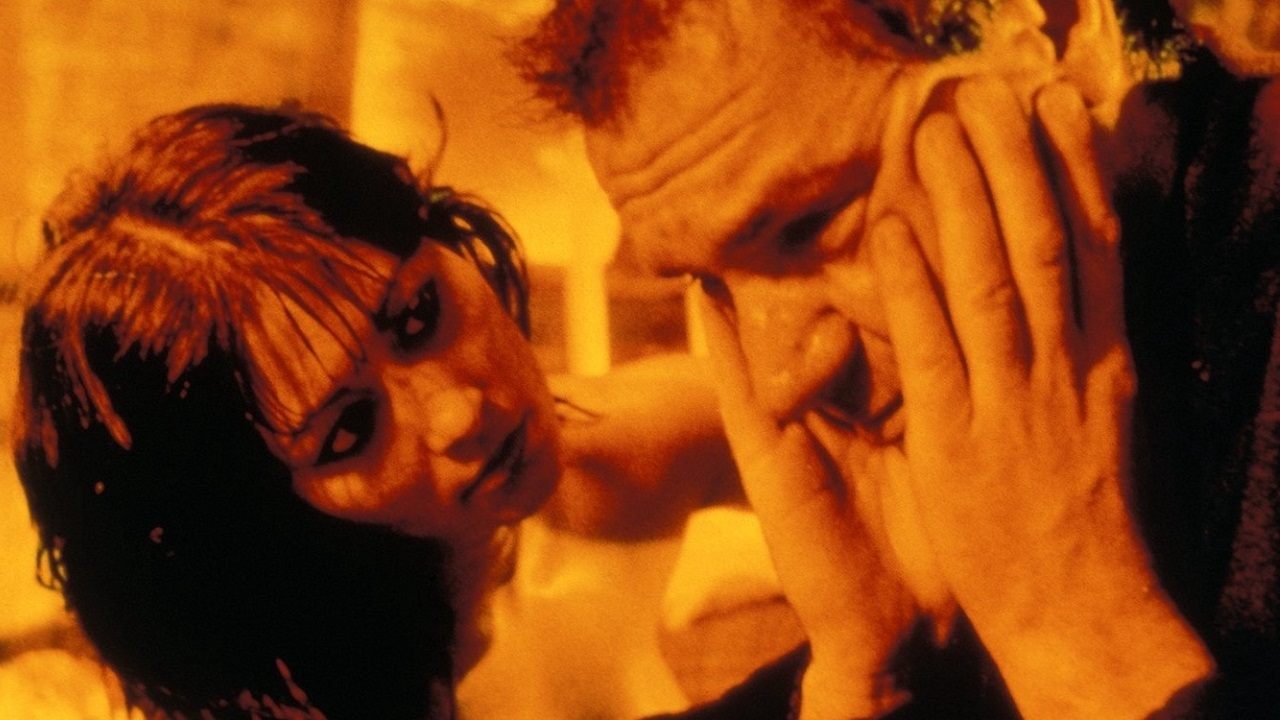ChristopherAdamPotes
I am an ardent fan of Lars von Trier, so my review my be perhaps slightly biased. A detective returns to Europe from abroad, yet it is a wasteland -- dark, dreary, crime-ridden, and backwards. The lighting, most of all, steals the show. It sets the mood, experience, and the interactions of the characters. It leaves the viewer engrossed. The characters are well developed and the part played by Michael Elphick provides an almost haunting experience through his voice. Overall, the first half is much more captivating than the latter half. The film, if one is not full acquainted with the style of the director, can seem to be endless. As for the Europa trilogy, of this film is a part -- this would be the second best. Europa (1991) is much better in style, while Epidemic (1987) is best not to be watched at all. I would rate this as a 7/10.
treywillwest
Von Trier's first film ranks with anything he's ever done visually, but otherwise it feels very much like a first movie, even a student film by a student of obvious genius. While Von Trier's visual influences are more obvious here than usual- namely, Tarkovsky, he borrows the style and perhaps transcends it. The use of water here is perhaps more dazzling than anything Tarkovsky achieved. Their are surfaces that seem impossible and dream-like, above and below the abyss at once. It is very dream-like, and that is a problem. The plot is a rather over-baked Kafka-ized noir cliché. As in "Europa," its all about how all is already written, but not in the religious, apocalyptic sense of his later work. Here, the apocalypse has already happened. All presence is absence. Which, I think, makes Von Trier a filmmaker alert to his cultural moment. Everything was inevitablest, post-modern irony until shortly before 911, and then the possibility of radical rupture re-introduced itself into the world, and into Von Trier's art. Change, be it glorious or disastrous, messianic or satanic, was and is again on the menu.
Graham Greene
Beginning a trilogy of films dealing specifically with the decline of post-war Europe, this extraordinary, heavily referential, psychological thriller would be the first cinematic outing from acclaimed Danish filmmaker Lars von Trier. Like all of the director's early works, the story is convoluted, and works best as an example of cinematic dream-logic, unfolding in an undisclosed European state, where day and night no longer exist, rain seems to be falling almost constantly and the only colour we see is a thick yellow sepia that is only occasionally pierced by jarring shafts of neon light. The story then builds on ideas of faith, redemption, love and mental anguish, familiar in symbolic rigour to the works of Ingmar Bergman - but with a fragmented composition and style more akin to the framing of Andrei Tarkovsky, or the industrial surrealism of David Lynch.From the opening images of a donkey basking in the hot sands of a Cairo desert (a metaphor for the central character and a reference in it's self to the Tarkovsky classic Andrei Rublev), to the waterlogged depiction of Europe, filled with burnt-out cars, decaying animal carcasses & lost children, The Element of Crime creates a world so murky, so damaged and so lost within the abyss, that it expressionistically conveys the sense of detachment and pain felt by the central protagonist, Fisher. Fisher is a washed up former detective, who after living in Cairo for a number of years, returns to his native Europe to help his mentor Osborn with a murder investigation. In the first scene - which takes place two months after the events of the main story - an unseen Fisher sits in a psychiatrist's office conversing with the doctor who promises to help him find the root to his problems. Here, von Trier is able to utilise one of his favourite narrative devises, hypnosis... as he blends together the character's psyche with the action in the film. From this point on, the entire film takes place from Fisher's point-of-view, his voice-over only rarely broken by the psychiatrist, who pops up to keep the story on track.In the lead role, the great Michael Elphick acquits himself admirably, though his role in the film (like all of the actors) is little more than a marionette to von Trier's demented puppet master (although, to be fair, with his rugged appearance and monotonous delivery of lines, he does successfully ease himself into the role of the gumshoe perfectly, brining to mind some of the genre's best-loved anti-heroes... for example, Philip Marlow from the Singing Detective fantasy sequences or Lemmy Caution from Godard's similarly dystopic masterpiece Alphaville). However, what is amazing about The Element of Crime far beyond acting, is von Trier's way of breaking down the genre - not content with producing a carbon copy of classic thrillers run through with art-house dramatics, he sets about subverting and destroying both design and ideology - like a schoolboy scribbling graffiti in a textbook, the result is jarring, criminally audacious and completely astounding. Here, white linen suits replace hats and trench coats, reflections are used in both mirrors and clouded puddles to heighten the idea of fragmented personalities and schizophrenia, just as the use of sepia printing suggests the murkiness to Fisher's subconscious. The neon lights that breaks the composition of the frame, usually from a police light or a flickering television set, act as beacons to the hidden depths of Fisher's mind - whenever some moment of remembrance occurs, a light will often be present to signify to the audience the usual emotion connected with the colour (blue - recollection, green - sickness, red - anger etc) - just as the use of double exposures and heavy sound-design build the flash-backs, dreamscapes and memories within memories.The other actors in the film are used like puppets to an even greater extent. Whereas Fisher is here for our benefit, they are there for his. Osborn for example, who is played with ailing charm by the great British actor Esmonde Knight (fans of Michael Powell will be familiar), gives the information that will lead both plot and dénouement, whilst the casting of Me-Me Lia as Kim again subverts the usual preconceptions of the femme-fatale by being a teasing, manipulative prostitute - with dark Asian looks that undercut the genre's usual 'wasp-ish' stereotypes. Her character presents both complications and a love interest/sidekick for Fisher, as well as other more meaningful purposes as the film moves towards the ambiguous climax - suggesting a state of abandonment and complete mental breakdown, as the shocking twists begin to pile up. Surpassing both A Clockwork Orange and 1984 in it's subversive attack and artistic vision, The Element of Crime presents to us a definitively dark and unrelenting image of Europe, in which chaos has overthrown order, analytical approaches to police work have been replaced by Gestapo bully tactics, and the chance of a changing season is nothing but a mere pipe dream.This is a staggering and inventive mish-mash of ideas and stylistic references that present us with an alluring potion of haunting images, heart-stopping bursts of violence, elaborate philosophies, unashamed pretension and a plot that writhes right the way through to its unflinching climax... which, coming from one of contemporary cinema's most important auteurs, should not be missed. Those familiar with his later works, such as Breaking the Waves, The Idiots and Dogville, may be surprised by von Trier's bold grasp of staggering cinematic technique and intelligent understanding of the conventions of post-war film-noir... something even more apparent in his later masterpiece, Europa.
nikhil7179
.. Or how to make a Tarkovskian Noir.Using all the staples of the master - the sepia overlay, the fluid tracking shots, the long takes, etc. Von Trier inverts the spiritual leanings of the former to serve his own nihilistic ends.Lars is a troublemaker and an obscenely gifted filmmaker - a lethal combination, and the result is a deeply unsettling and equally engaging piece of work, which more than hints at the greatness to follow.Tom Elling's dexterous and inventive cinematography is par excellence - a milestone in terms of technical and aesthetic brilliance.One of the more interesting debut films ever made, Von Trier channels The Third Man, Borges and even Hitchcock as he playfully sets up his cinematic game of cat and mouse.Of course, plot/meaning as Fisher himself finds out, is secondary to mood.


 AD
AD



